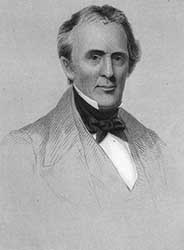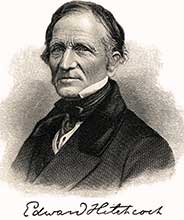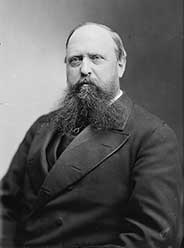Noah's Raven Discovery
It is very likely that the existence of dinosaur tracks was known to others, particularly the Native Americans. However, the first recorded discovery of dinosaur tracks was made by a teenager, Pliny Moody, on his family's farm in South Hadley, Massachusetts, part of the Connecticut Valley. This discovery was made in 1802 and young Moody did not entirely understand the nature of his find. He described the tracks as coming from a large bird, such as a turkey. It wasn't until the 1840s that dinosaurs were eventually defined and it has since been determined that the Moody find was a plant-eating early ancestor of the dinosaurs. The story goes that Moody took the fossil to his home and used it as a door stop. It was named by the local doctor "The tracks of Noah's Raven" and the name stuck. The title "Noah's Raven" comes from the biblical story of Noah when caught in the 40 day flood with his family in an ark. At the end of the 40 days he released a raven to see if the land had dried. The idea probably adopted by the local doctor was that the tracks were made by a random bird several thousand years previously. What he did not realize is that the tracks were made at a time long before the biblical account of Noah.
 |
| Benjamin Silliman. |
Benjamin Silliman and "The Bones from the Well"
Benjamin Silliman was born on the 8th of August, 1779 in Trumbull, Connecticut. He was born into the Revolutionary war in which his father was a general. In 1796 he graduated from Yale University and was soon after employed there as a teacher of chemistry and geology. He had considerable influence on many of his students. He also served as a founder of the Peabody Museum of Natural History, one of the key museums of paleontology. In 1836 he published his first study of trace fossils including those found in the valley. He died in 1864.
Silliman was involved in the first recorded dinosaur bone discovery in North America known as "The Bones from the Well." The bones were found in 1818 by blasting rock away to build a well. He published a report on the find in the American Journal of Science. They were described by Silliman as, "evidently those of a perfect and considerably large animal." However, he did not consider them to be interesting at the time. Instead the headlines were taken by the discovery of the Megalosaurus during the same year in England. The Megalosaurus is considered the first recorded dinosaur discovery, even though "The Bones from the Well" were found at the same time. These bones were later connected to giant reptiles by Edward Hitchcock. O. C. Marsh later commented in his book The Dinosaurs of North America, "It is a remarkable fact that the first discovery in this sandstone was that of the skeleton of a true dinosaur, found in East Windsor, Connecticut, in 1818, many years before the first footprints were recorded." It is currently unknown which dinosaur they belonged to but it has been described as being similar to other dinosaur bones found in the valley such as the Plateosaurus.
 |
| Edward Hitchcock. |
Edward Hitchcock
A history of the Connecticut Valley would not be complete without mention of Edward Hitchcock. He was born on May 24th, 1793 in Deerfield, Massachusetts. From the start he had a love of science, spending every spare moment studying. He studied so much in fact that it resulted in many health problems from over-studying and over-working himself. A brush with the mumps blinded him in 1814. Luckily, he regained his sight two years later and was able to continue his study. He became the leading expert on the valley in which he lived. Even though he had little formal training his expertise earned attention. It was in 1825 that he began study of chemistry at Yale from none other than Benjamin Silliman. As his life progressed he pursued the study of anatomy, botany, chemistry, geology, zoology. At the time very little material was available in many of these subjects. However, this did not stop him. If the information he sought was not available, he taught himself whatever he could not find in his study. This allowed him to become one of the top minds in his field.
In 1825 he was made geologist to the State of Massachusetts and published many articles in the American Journal of Science. He began to study Ornithichnology, a forerunner of Ichnology, the study of trace fossils. The name meant "stony bird-tracks" a term coined by himself. In 1836 he tried to describe seven different species of giant birds but his report was not adopted by most, with the exception of his teacher Silliman, and the discoverer of the Megalosaurus, William Buckland. In the report he noted over 30 data fields, including the dinosaur's shape and size, whether it walked on two legs or four, its gait, etc. In his studies he concluded that many of the footprints were from long extinct flightless birds. It appeared that the birds were huge and had a very long gait in most cases. He later became absorbed by the prints and their implications. Once he stated, "This animal turns out to have been one of the most common of all that trod upon the muddy shores...I regarded it as the giant ruler of the valley" Hitchcock's claims met with a lot of criticism at first, however, they were later accepted as the best possible explanation and endorsed by the Association of Geologist and Naturalists in 1841.
It was later that a man named Richard Owen made a bone discovery in New Zealand of what looked like a giant bird. It was named Dinornis. Hitchcock believed an animal like the Dinornis could have been responsible for the tracks made in the Connecticut Valley. Richard Owen is most famous for coining the word dinosaur, meaning "terrible lizard," in 1842. Together they argued that birds, instead of reptiles, were descended from these dinosaurs. This discussion continues until this day. Near the end of Hitchcock's life more evidence was discovered, including fossilized skin samples, that suggested that the dinosaurs were indeed bird-like with reptilian aspects as well. They were, in a sense a combination of the two. In 1869 with this new evidence Edward Drinker Cope classified the Connecticut Valley footprints as dinosaur tracks, five years after Hitchcock's death in 1864. At the conclusion of his life Hitchcock had described over 20,000 fossils and had provided valuable information for all paleontologists, geologists, and ichnologists to come.
 |
| Othniel Charles Marsh. |
Othniel Charles Marsh
Othniel Charles Marsh is considered by many to the one of the greatest, if not the greatest paleontologist of all time. Marsh was born on October 29th, 1831 in Lockport, New York. As a boy he had a fascination for geology and fossils. He was first taught and encouraged by a local professional, Ezekiel Jewett. He collected several fossils in his youth and in 1855 found some unusual spine fragments. He published the resulting study as belonging to a dinosaur named Eosaurus. After his mother's death at age 3, he was looked after by a very rich uncle George Peabody. Peabody died in 1869 and left his fortune to Marsh. Marsh used the money to make many of his lifetime breakthroughs and contributions in paleontology.
Marsh was a Yale graduate and remains an extremely famous paleontologist. In 1884 he found the rear portion of a dinosaur encased in a stone quarry, close to Manchester, Connecticut. The front portion of the dinosaur had already been taken away and used in any one of the many blocks in Hop Brook Bridge. The bridge was torn down 85 year later and the front half was found by paleontologist John Ostrom. Even though he never found the missing half, because of this discovery Marsh was able to find two more nearly complete skeletons in the Wolcott Quarry. These two skeletons were described as the Anchisaurus and Ammosaurus. The Wolcott Quarry has remained the most yielding bone site excavated in the Valley.
Mention of Othniel Charles Marsh would not be complete without mention of his biggest rival, Edward Drinker Cope. Because of their heated rivalry, the two competitors found a lot of dinosaurs as did many others following their footsteps. Some of the dinosaurs found by Marsh in those days were the Apatosaurus, Stegosaurus, and Triceratops. This time period, between 1870-1890, was known as the "bone rush" and is considered the golden age of paleontology. Marsh would bring many of his finds to the Peabody Museum and died in 1888 leaving his entire collection of bones and fossils to Yale.
Post 1900s
The study of the Connecticut Valley has continued with others such as Richard Swann Lull, a popular teacher. It was he that was responsible for most of the restoration, preservation, and exhibition of bones in the Peabody Museum. Displaying a full dinosaur skeleton was not an easy task and required very complex support systems. Lull also studied and calculated several possible positions of dinosaurs when some of the dinosaur tracks contained in the museum were originally made. Among other things Lull became the director of the Peabody museum as well as editor of the American Journal of Science.
Other contributors to the world of paleontology and the Connecticut Valley include John Ostrom and Paul Olsen. When the Hop Brook Bridge was torn down 85 years after it was built, John Ostrom was there waiting for it. As a result the missing half of the dinosaur discovered by Marsh was found and united with its other half. Ostrom also revived the idea that birds were descended from dinosaurs, a theory now generally accepted. Paul Olsen is primarily responsible for the modern view and theories on dinosaur genesis and extinction. Because of these and many other individuals, our knowledge of dinosaurs and sites like the Connecticut Valley has been greatly influenced and enhanced.